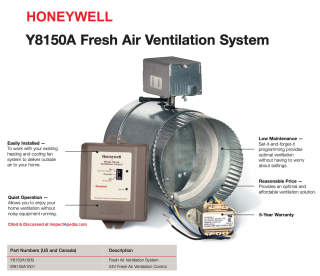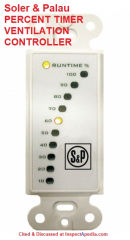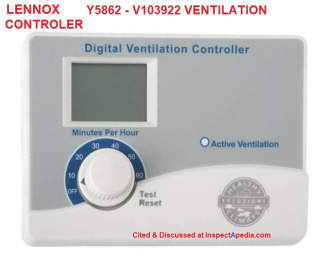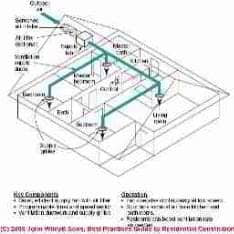 Supply-Only Fresh Air Ventilation System Design
Supply-Only Fresh Air Ventilation System Design
- POST a QUESTION or COMMENT about supply-only fresh air ventilation system designs, installation, troubleshooting
Supply air ventilation system design:
this article explains how and why to use supply-only ventilation to improve indoor air quality in homes.
InspectAPedia tolerates no conflicts of interest. We have no relationship with advertisers, products, or services discussed at this website.
- Daniel Friedman, Publisher/Editor/Author - See WHO ARE WE?
Supply-Only Fresh Air Ventilation System Design & Features
 At the Alhambra in Spain (our photo at left) windows are always open and fresh air flows through the buildings continuously. But in modern enclosed buildings, a different strategy is needed to provide adequate fresh air and good indoor air quality.
At the Alhambra in Spain (our photo at left) windows are always open and fresh air flows through the buildings continuously. But in modern enclosed buildings, a different strategy is needed to provide adequate fresh air and good indoor air quality.
As reported in Best Practices Guide to Residential Construction (Steve Bliss, J Wiley & Sons) :
While not widely used, supply-only systems have distinct advantages over exhaust systems. The incoming air is easily filtered and can be directed to bedrooms and main living areas. The slight positive pressure helps guard against radon, backdrafting, and other problems associated with negative pressures.
[Click to enlarge any image]
In cold climates, however, delivering nontempered air can lead to uncomfortable drafts. Also, forcing moist, interior air out through gaps in the building shell could contribute to condensation problems in building cavities and between prime and storm windows.
In airtight homes in very cold climates, supply-only systems have reportedly iced up keyholes to entry doors as exfiltrating warm, moist air came in contact with the cold metal. Adding a single exhaust fan wired to operate whenever the supply fan switches on can alleviate these problems.
Below we discuss two types of supply-only building ventilation approaches, followed by a discussion
of VENTILATION, BALANCED designs.
- Forced-air supply piggybacking off of an existing HVAC system
- Multiport supply ventilation systems
Forced-Air Supply Ventilation Piggybacks on Existing HVAC System
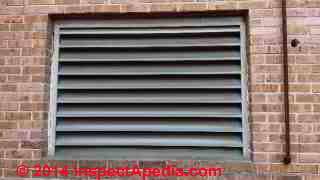 A multiport forced air home ventilation system piggybacks on the
ductwork of a central heating or cooling system by running
an intake duct from outside into the return ductwork.
A multiport forced air home ventilation system piggybacks on the
ductwork of a central heating or cooling system by running
an intake duct from outside into the return ductwork.
The screened intake has a motorized damper that is timed to open when ventilation is needed, blending fresh air into the HVAC system and slightly pressurizing the house.
A special controller is needed to control the damper and fan, activating the damper whenever ventilation is needed and activating the fan whenever the air handler has not run for a set period of time, typically 20 minutes.
Several manufacturers, including Lipidex Corporation, Tjernlund, and Honeywell, make controllers for this application.
One manufacturer, American Aldes, offers a packaged system for warm, humid climates: the DHV-100V, which dehumidifies and filters incoming air and integrates with the home’s central air-conditioning system.
This approach is relatively inexpensive since it uses existing ductwork, and it provides good distribution of fresh air. The chief drawback is that ventilation is required at regular intervals, often when the HVAC system is not operating. At those times, the controller will switch on the air handler, which is typically noisy and inefficient, making this the most expensive system to operate.
Also, delivering untempered outside air through the duct system can cause discomfort in very hot or cold weather. And if the return ducts are not well sealed, they can pull contaminants from attic or basement spaces into the ventilation system.
The operating costs can be cut in half by replacing the standard air-handler blower with an efficient, variable- speed fan with an integrated control motor (ICM). The fan would work on high speed for heating and cooling and continuous low speed for ventilation-only, cutting operating costs in half.
However, the damper adjustment that provides the right amount of ventilation air at 500 cfm Laboratory (LBNL) as the optimal system for tract homes will produce too little when run at 100 cfm. Either the based on first cost, operating costs, air distribution, and the setting has to be changed seasonally or a compromise level potential health and safety benefits of positive pressures. found. It is also easy to filter and, if necessary, to dehumidify the incoming air (Figure 7-4 below).
Multiport Supply House Ventilation System to Improve Indoor Air Quality

Although the least common type of ventilation system, the multiport supply system was identified in a recent study by Lawrence Berkeley National Laboratory (LBNL) as the optimal system for tract homes based on first cost, operating costs, air distribution, and the potential health and safety benefits of positive pressures.
It is also easy to filter and, if necessary, to dehumidify the incoming air.
See our figure at left for details about a multi-port fresh air supply whole house ventilation system.
Though not widely used, supply-only ventilation has several advantages: incoming air can be easily filtered and distributed to the rooms where it is needed, and positive pressures help guard against backdrafting and radon entry.
Illustration Source: Recommended Ventilation Strategies for Energy-Efficient Production Homes, 1998, by Judy A. Roberson, et al., Lawrence Berkeley National Laboratory, appearing in the text cited above.
While few packaged systems are currently available, one manufacturer, Tamarack Technologies, offers a unit with a replaceable filter and an efficient variable-speed fan that provides 90 cfm of ventilation through one 3-inch and three 2-inch ducts.
Since these systems pressurize the house, the LBNL study recommends that, in cold climates, the supply fan be balanced by a single-port exhaust fan, which could also serve as a bathroom fan. In this type of system, a central fan, typically in the attic or basement, draws in outside air through a filter and delivers it through ducts to bedrooms and main living areas.
The supply ductwork should be in conditioned space or insulated and sealed airtight. Supply grilles should be placed high on the wall away from beds, chairs, or other places where drafts could cause discomfort.
Since these systems pressurize the house, the LBNL study recommends that, in cold climates, the supply fan be balanced by a single-port exhaust fan, which could also serve as a bathroom fan. In this type of system, a central fan, typically in the attic or basement, draws in outside air through a filter and delivers it through ducts to bedrooms and main living areas.
The supply ductwork should be in conditioned space or insulated and sealed airtight.
Supply grilles should be placed high on the wall away from beds, chairs, or other places where drafts could cause discomfort.
- - Adapted with permission from Best Practices Guide to Residential Construction (Steve Bliss, J Wiley & Sons) .
Fresh Air Ventilation Supply-Only Systems: Ducts & Controllers
Illustration: Honeywell's Fresh Air Ventilation System, cited below. [Click to enlarge any image]
- AirKing AIR KING QuFresh FRESH AIR SUPPLY FAN INSTALLATION MANUAL [PDF] (2015) Customer Service tel: 800-465-7300 Website: www.airkinglimited.com
US: Air King America, LLC 820 Lincoln Avenue West Chester, PA 19380 Phone: 877-304-3785 Fax: 610-696-8048 Email: sales@airkinglimited.com
Canada: Air King Limited, LLC PO Box 44130 Wexford Square PO Brampton, ON L6Z 4V7 Phone: 800-465-7300 Email: casales@airkinglimited.com
30 to 130 CFM blower specifically designed for continuous use. Designed for use with a smart thermostat (purchase separately) - Aprilaire: APRILAIRE MODEL 8145 FRESH AIR INTAKE VENTILATOR MANUAL [PDF] (2020) AprilairePartners.com
P.O. Box 1467
Madison, WI 53701-1467
800.334.6011 F: 608.257.4357
Printed in USA Aprilaire –Division of Research Products Corporation
Product desciption except:
Aprilaire 8145 pulls in outside air and mixes with your home’s return air on the HVAC system. Up to 250 cubic feet of airflow (CFM) is whisked around the home, pushing stale air out through passive venting spots, such as kitchen vent hoods, fireplaces, and bathroom exhausts. - HONEYWELL Y8150A FRESH AIR VENTILATION SYSTEM CONTROLLER [PDF] (2009) product literature - shown above, Honeywell Automation and Control Solutions
Honeywell
1985 Douglas Drive North
Golden Valley, MN 55422-3992 USA Tel: 1-800-328-5111
web: http://customer.honeywell.com
Email: info@honeywell.com
Excerpt: The Y8150 Fresh Air Ventilation System from Honeywell provides optimal ventilation for improved indoor air quality at an affordable price for your home. A “set it and forget it” program calculates the amount of ventilation needed in your home based on your custom settings. - HONEYWELL Y8150 / W8150 FRESH AIR VENTILATION SYSTEM & CONTROLLER INSTALLATION INSTRUCTIONS [PDF] (2009) Op. Cit.
Excerpt: The Y8150 Fresh Air Ventilation System, W8150 Fresh Air Ventilation Control provide fresh air to a home.
The control operates a fresh air intake damper and, when necessary, activates the main HVAC blower to efficiently meet ASHRAE ventilation rates. - iO FRESH AIR VENTILATION CONTROL PANEL INSTALLATION MANUAL [PDF] - 10" Round 2-Position Damper # iO-FAV-10, iO HVAC Controls Co., 5351 East Thompson Road, Suite 142
Indianapolis, IN 46237
USA, Tel: 888.359.0362 Email:
info@iohvaccontrols.com
Web: www.iohvaccontrols.com
Exerpt: The fresh air ventilation system is designed to introduce fresh air into a building through an intake damper controlled by a micro-processor logic panel.
The iO-FAV has single adjustment setup, exhaust fan control option, outdoor temperature and/or humidity limit option and damper override capabilities.
It is easy-to-install and meets ASHRAE 62.2 standard. The iO-FAV comes with a 20VA transformer and 8” round damper. The control panel is available separately (iO-FAVPAN) and can be ordered with additional size dampers.
- Soler & Palau, VENTILATION FAN RUN PERCENTAGE TIMER SWITCH, # 6XAU2 INSTRUCTION SHEET [PDF] Soler & Palau
USA: Tel (800) 961-7370, Fax (800) 961-7379, www.solerpalau-usa.com
Canada: Tel (866) 733-0233, Fax (866) 358-5346, www.solerpalaucanada.net
Mexico: Tel 52 (222) 2 233 900, Fax 52 (222) 223 3914, www.soler-palau.com.mx
...
Reader Comments, Questions & Answers About The Article Above
Below you will find questions and answers previously posted on this page at its page bottom reader comment box.
Reader Q&A - also see RECOMMENDED ARTICLES & FAQs
Question: How do I turn off our fresh air ventilation system
(Feb 5, 2013) Michelle said:
How do we turn it off? It blows ice cold air in winter and hot air in summer, which is separate from AC and heat.
Reply:
Michelle, you will find an electrical switch for the supply vent fan, typically located on the equipment or next to it as well as in the main electrical panel. But it sounds as if your supply ventilation system is either not properly designed or not installed correctly.
As we illustrate with this Lennox active ventilation controller, on just about all fresh air ventilation systems you will find an independent controller with buttons or a dial that allow you to specify the amount of "on-time" or to turn the ventiation system off completely.
This ventilation controller and others like it are discussed and their installation and operation manuals are provided
You will read that where ventilation systems are installed in very cold climates the control should provide for keeping the venting system off under certain conditions such as very low outdoor temperatures or when indoor relative humidity is above 55% RH.
Watch out: do not turn off fresh air supply provided to building heating equipment such as boilers or water heaters or furnaces.
Doing so may result in inadequate combustion air, back drafting, and fatal carbon monoxide hazards - ie. you could kill building occupants.
...
Continue reading at VENTILATION, BALANCED or select a topic from the closely-related articles below, or see the complete ARTICLE INDEX.
Or see these
Recommended Articles
- BLOWER FAN CYCLES ON INTERMITTENTLY - is a ventilation systm turning on and off the air handler fan?
- HUMIDIFIERS & HUMIDITY TARGET where humidity issues around supply-only ventilation systems or PIVs are also discussed.
- INDOOR AIR QUALITY & HOUSE TIGHTNESS
- VENTILATION in BUILDINGS - home
Suggested citation for this web page
VENTILATION, SUPPLY-ONLY at InspectApedia.com - online encyclopedia of building & environmental inspection, testing, diagnosis, repair, & problem prevention advice.
Or see this
INDEX to RELATED ARTICLES: ARTICLE INDEX to BUILDING VENTILATION
Or use the SEARCH BOX found below to Ask a Question or Search InspectApedia
Ask a Question or Search InspectApedia
Try the search box just below, or if you prefer, post a question or comment in the Comments box below and we will respond promptly.
Search the InspectApedia website
Note: appearance of your Comment below may be delayed: if your comment contains an image, photograph, web link, or text that looks to the software as if it might be a web link, your posting will appear after it has been approved by a moderator. Apologies for the delay.
Only one image can be added per comment but you can post as many comments, and therefore images, as you like.
You will not receive a notification when a response to your question has been posted.
Please bookmark this page to make it easy for you to check back for our response.
Our Comment Box is provided by Countable Web Productions countable.ca
Citations & References
In addition to any citations in the article above, a full list is available on request.
- Steve Bliss's Building Advisor at buildingadvisor.com helps homeowners & contractors plan & complete successful building & remodeling projects: buying land, site work, building design, cost estimating, materials & components, & project management through complete construction. Email: info@buildingadvisor.com
Steven Bliss served as editorial director and co-publisher of The Journal of Light Construction for 16 years and previously as building technology editor for Progressive Builder and Solar Age magazines. He worked in the building trades as a carpenter and design/build contractor for more than ten years and holds a masters degree from the Harvard Graduate School of Education. Excerpts from his recent book, Best Practices Guide to Residential Construction, Wiley (November 18, 2005) ISBN-10: 0471648361, ISBN-13: 978-0471648369, appear throughout this website, with permission and courtesy of Wiley & Sons. Best Practices Guide is available from the publisher, J. Wiley & Sons, and also at Amazon.com - Our recommended books about building & mechanical systems design, inspection, problem diagnosis, and repair, and about indoor environment and IAQ testing, diagnosis, and cleanup are at the InspectAPedia Bookstore. Also see our Book Reviews - InspectAPedia.
- Decks and Porches, the JLC Guide to, Best Practices for Outdoor Spaces, Steve Bliss (Editor), The Journal of Light Construction, Williston VT, 2010 ISBN 10: 1-928580-42-4, ISBN 13: 978-1-928580-42-3, available from Amazon.com
- Historic Preservation Technology: A Primer, Robert A. Young, Wiley (March 21, 2008) ISBN-10: 0471788368 ISBN-13: 978-0471788362
- VAPOR BARRIERS or VAPOR DIFFUSION RETARDERS [PDF] U.S. DOE - how vapor barriers work, types of vapor diffusion barriers, installing vapor barrier
- VENTILATION for ENERGY-EFFICIENT BUILDINGS [PDF] Purpose of ventilation, ventilateion strategies, etc.
- Weather-Resistive Barriers, how to select and install housewrap and other types of weather resistive barriers, U.S. DOE
- Whole House Ventilation Systems, U.S. Department of Energy
- Whole-House Balanced Ventilation Systems, U.S. Department of Energy
- Whole-House Exhaust Ventilation Systems, U.S. Department of Energy
- Whole-House Supply Ventilation Systems, U.S. Department of Energy
- In addition to citations & references found in this article, see the research citations given at the end of the related articles found at our suggested
CONTINUE READING or RECOMMENDED ARTICLES.
- Carson, Dunlop & Associates Ltd., 120 Carlton Street Suite 407, Toronto ON M5A 4K2. Tel: (416) 964-9415 1-800-268-7070 Email: info@carsondunlop.com. Alan Carson is a past president of ASHI, the American Society of Home Inspectors.
Thanks to Alan Carson and Bob Dunlop, for permission for InspectAPedia to use text excerpts from The HOME REFERENCE BOOK - the Encyclopedia of Homes and to use illustrations from The ILLUSTRATED HOME .
Carson Dunlop Associates provides extensive home inspection education and report writing material. In gratitude we provide links to tsome Carson Dunlop Associates products and services.


